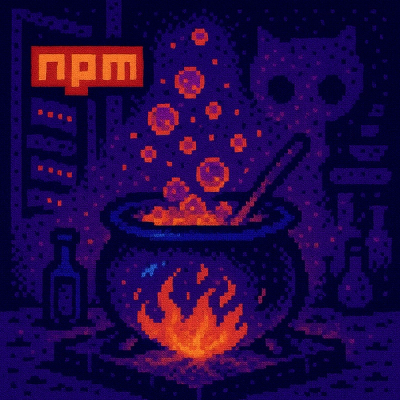
Security News
How Enterprise Security Is Adapting to AI-Accelerated Threats
Socket CTO Ahmad Nassri discusses why supply chain attacks now target developer machines and what AI means for the future of enterprise security.
RedisMPX is a Redis Pub/Sub multiplexer library written in multiple languages and live coded on Twitch.
When bridging multiple application instances through Redis Pub/Sub it's easy to end up needing support for multiplexing. RedisMPX streamlines this process in a consistent way across multiple languages by offering a consistent set of features that cover the most common use cases.
The library works under the assumption that you are going to create separate subscriptions for each client connected to your service (e.g. WebSockets clients):
Requires Python 3.7+, based on aio-libs/aioredis, an AsyncIO Redis client.
pip install redismpx
from redismpx import Multiplexer
# Pass to Multiplexer the same connection options that
# aioredis.create_connection() would accept.
mpx = Multiplexer('redis://localhost')
# on_message is a callback (can be async)
# that accepts a channel name and a message.
async def my_on_message(channel: bytes, message: bytes):
await websocket.send(f"ch: {channel} msg: {message}")
# on_disconnect is a callback (can be async)
# that accepts the error that caused the disconnection.
def my_on_disconnect(error: Exception):
print("oh no!")
# on_activation is a callback (can be async)
# that accepts the name of the channel or pattern
# whose subscription just became active (depends
# on whether it's attached to a ChannelSubscription
# or a PatternSubscription).
def my_on_activation(name: bytes):
print("activated:", name)
# you can also pass None in place of `on_disconnect`
# and `on_activation` if you're not interested in
# reacting to those events.
# Use `mpx` to create new subscriptions.
channel_sub = mpx.new_channel_subcription(
my_on_message, my_on_disconnect, None)
pattern_sub = mpx.new_pattern_subscription("hello-*",
my_on_message, None, my_on_activation)
promise_sub = mpx.new_promise_subscription("hello-")
# Create the ChannelSubscription.
channel_sub = mpx.new_channel_subcription(
lambda ch, msg: print(f"Message @ {ch}: {msg}"),
lambda e: print(f"Network Error: {type(e)}: {e}"),
lambda s: print(f"Subscription now active: {s}"))
# Add channels
channel_sub.add("chan1")
channel_sub.add("chan2")
channel_sub.add("chan3")
# Remove a channel
channel_sub.remove("chan2")
# Close the subscription
channel_sub.close()
# Create the PatternSubscription.
# Note how it also requires the pattern.
pattern_sub = mpx.new_pattern_subcription(
"notifications:*",
lambda ch, msg: print(f"Message @ {ch}: {msg}"),
lambda e: print(f"Network Error: {type(e)}: {e}"),
lambda s: print(f"Subscription now active: {s}"))
# PatternSubscriptions can only be closed
pattern_sub.close()
# Create the subscription.
# Note how it doesn't accept any callback.
promise_sub = mpx.new_promise_subscription("hello-")
# When first created (and after a network error that causes
# a reconnection), a PromiseSubscription is not immediately
# able to create new promises as it first needs the underlying
# PatternSubscription to become active. This async function
# waits for that event.
await promise_sub.wait_for_activation()
# Create a new promise. It might fail if the subscription is
# not active.
try:
promise = promise_sub.new_promise("world", 10)
# The provided suffix will be composed with the subscription's
# prefix to create the final Redis Pub/Sub channel from which
# the message is expected to come. In this example, to fullfill
# the promise you could send, using redis-cli (or any other client):
#
# > PUBLISH hello-world "your-promise-payload"
#
except redismpx.InactiveSubscription:
# Wait and then Retry? Return an error to the user? Up to you.
# A way of creating a promise that ensures no InactiveSubscription error
# will trigger. Note that this method needs to be awaited.
# The timer will start only after the promise has been created.
promise = await promise_sub.wait_for_new_promise("world", 10)
# A Promise represents a timed, uninterrupted, single-message
# subscription to a Redis Pub/Sub channel. If network
# connectivity gets lost, thus causing an interruption,
# the Promise will be failed (unless already fullfilled).
# Resolve the promise
try:
result = await promise
print(result) # prints b'your-promise-payload'
except asyncio.TimeoutError:
# The promise timed out.
except asyncio.CancelledError:
# The promise was canceled. This happens when
# a reconnection event triggers while the promise
# is not yet resolved.
# Close the subscription (will automatically cancel all
# outstanding promises and unlock all `wait_for_*` waiters).
promise_sub.close()
This is a more realistic example of how to use RedisMPX.
This code is also available in examples/channel.py.
# channel.py
import asyncio
import aioredis
from starlette.applications import Starlette
from starlette.routing import WebSocketRoute
from redismpx import Multiplexer
# Pass to Multiplexer the same connection options that
# aioredis.create_redis() would accept.
mpx = Multiplexer('redis://localhost')
pub_conn = None
async def handle_ws(ws):
global pub_conn
await ws.accept()
# Create a separate connection for publishing messages:
if pub_conn is None:
pub_conn = await aioredis.create_redis('redis://localhost')
# Define a callback that sends messages to this websocket
async def on_message(channel: bytes, message: bytes):
await ws.send_text(f"ch: [{channel.decode()}] msg: [{message.decode()}]\n")
# Create a subscription for this websocket
sub = mpx.new_channel_subscription(on_message,
lambda e: print(f"Network Error: {type(e)}: {e}"),
lambda s: print(f"Subscription now active: {s}"))
# Keep reading from the websocket, use the messages sent by the user
# to add and remove channels from the subscription.
# Use +channel to join a channel, -channel to leave.
# Sending !channel will send the next message to said channel.
await ws.send_text('# Use +channel to join a channel, -channel to leave.')
await ws.send_text('# Sending !channel will send the next message to said channel.')
await ws.send_text('# To see a message sent to a given channel, you must have joined it beforehand.')
while True:
msg = None
try:
msg = await ws.receive_text()
except:
print('ws disconnected')
sub.close()
return
prefix, chan = msg[0], msg[1:]
if prefix == "+":
sub.add(chan)
elif prefix == "-":
sub.remove(chan)
elif prefix == '!':
# Send the next message to the given channel
await pub_conn.publish(chan, await ws.receive_text())
app = Starlette(debug=True, routes=[
WebSocketRoute('/ws', endpoint=handle_ws),
])
pip install redismpx aioredis starlette uvcorn
$ uvicorn websocket:app
The application works like a simple WebSocket chat application that expects commands from the user.
+hello will subscribe you to channel hello, while -hello will do the opposite.!hello will broadcast the next message you send to hello.To send those commands you can use a browser:
// To create a websocket connection to localhost
// you will need to deal with the browser's security
// policies. Opening a file on the local filesystem
// and typing these commands in the console should
// do the trick.
let ws = new WebSocket("ws://localhost:8000/ws")
ws.onmessage = (x) => console.log("message:", x.data)
ws.send("+test")
ws.send("!test")
ws.send("hello world!")
A more handy way of interacting with websockets are command-line clients:
FAQs
A Redis Pub/Sub multiplexer.
We found that redismpx demonstrated a healthy version release cadence and project activity because the last version was released less than a year ago. It has 1 open source maintainer collaborating on the project.
Did you know?

Socket for GitHub automatically highlights issues in each pull request and monitors the health of all your open source dependencies. Discover the contents of your packages and block harmful activity before you install or update your dependencies.

Security News
Socket CTO Ahmad Nassri discusses why supply chain attacks now target developer machines and what AI means for the future of enterprise security.

Security News
Learn the essential steps every developer should take to stay secure on npm and reduce exposure to supply chain attacks.

Security News
Experts push back on new claims about AI-driven ransomware, warning that hype and sponsored research are distorting how the threat is understood.